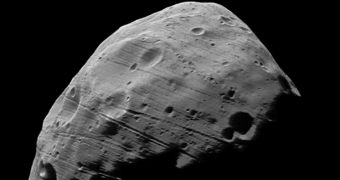According to a new scientific study, it would appear that the material which makes up the Martian moon Phobos was created billions of years ago, when a comet or asteroid impacted the Red Planet.
This theory is remarkably similar to the one seeking to explain how our own Moon formed. Experts say it coalesced from the debris produced when two Venus-sized bodies slammed into each other to produce Earth.
Studies conducted on Phobos would seem to indicate this was the case around our neighboring planet as well. The past impact may have been so strong that a vast amount of material was cast into space.
The investigation into the space object's origins was prompted by its peculiar inner structure and shape, which do not resemble those of a naturally-formed moon, Space reports.
The rock is shaped like a potato, and is also very small in size. Whereas the Moon is a considerable portion of the Earth's mass, Phobos is insignificant when compared to the Red Planet.
In fact, experts say, its average radius is no larger than 11 kilometers (6.8 miles), which makes it but a speck of dust when compared to Mars. These properties have made experts wonder about the formation's origins for years.
When it was first discovered, many believed that it was a former asteroid, that had become trapped in Martian orbit, unable to escape the planet's strong gravitational pull.
Other researchers said that Phobos was produced from the same heap of matter that gave birth to Mars itself, while yet another group advocated the catastrophic impact hypothesis.
Using the latest data available on the moon, researchers determined that the third idea had the most merit, and that Phobos most likely coalesced from debris.
The inner composition of the space rock was analyzed using data collected by the European Space Agency (ESA) Mars Express spacecraft, says that team behind the work.
The data showed that Phobos does not share the same composition as other asteroids. Additionally, it features minerals called phyllosilicates, which form on Mars as well.
“This is very intriguing as it implies the interaction of silicate materials with liquid water on the parent body prior to incorporation into Phobos,” explains expert Marco Giuranna.
The scientist, who is based at the Instituto Nazionale di Astrofisica in Rome, Italy, was also a coauthor of the new investigation.
“Alternatively, phyllosilicates may have formed in situ, but this would mean that Phobos required sufficient internal heating to enable liquid water to remain stable,” he adds.
The latter variant is impossible. Tectonic processes cannot exist on a body the size of Phobos.

 14 DAY TRIAL //
14 DAY TRIAL //